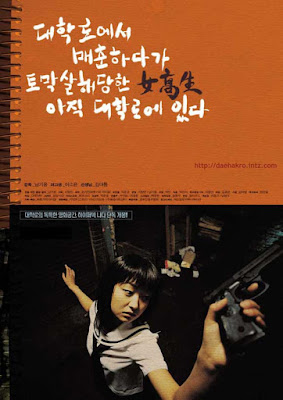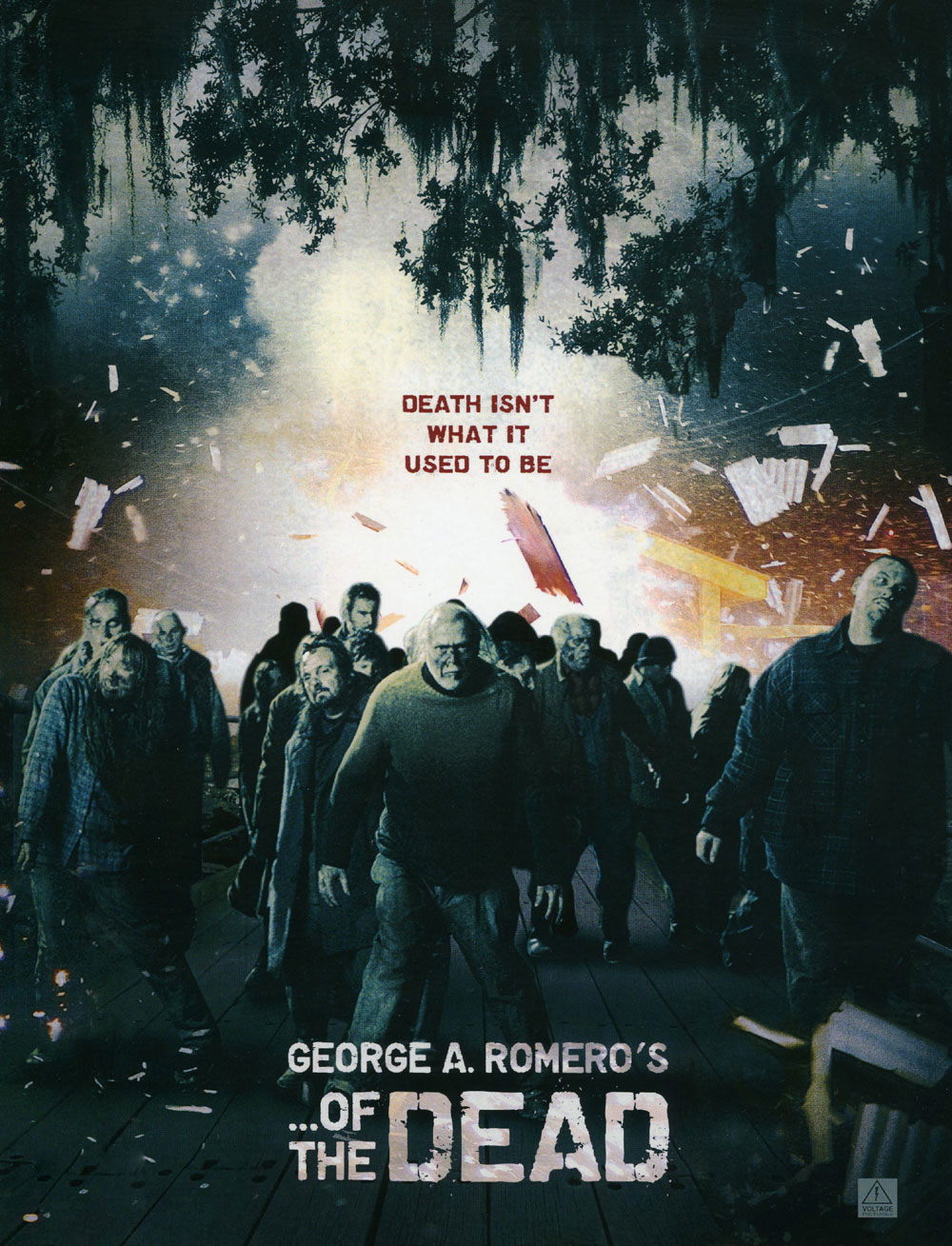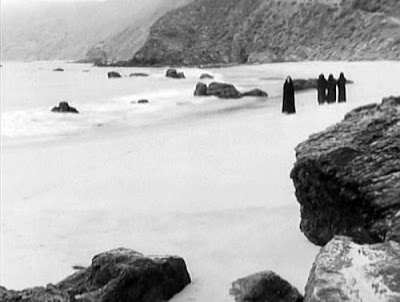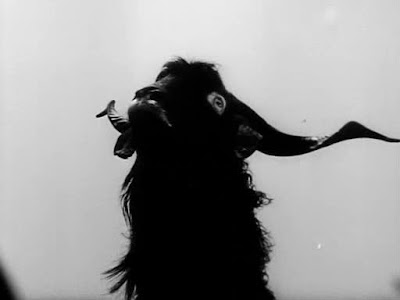 |
From http://images.moviepostershop.com/teenage-hooker-became-killing-machine
-in-daehakroh-movie-poster-2000-1020509430.jpg |
aka. Teenage Hooker Became A Killing Machine in Daehakroh
Director: Gee-woong Nam
Screenplay: Gee-woong Nam
Cast: So-yun Lee (as the Teenage
Hooker), Dae-tong Kim (as The Teacher)
 Synopsis
Synopsis: A schoolgirl prostitute (
Lee) is caught having sex with a client against the wall of a woman's
apartment. The woman's son, the schoolgirl's teacher (
Kim) gets his three brothers to dispose of her gruesomely as
punishment...only for a secret organisation to bring her back as a
biomechanical assassin.
Teenage Hooker Became A Killing Machine is an eye-catching title
but the results, only sixty minutes long, are a lot more unexpected than anyone
could expect, especially from those hoping for a film like Noboru Iguchi's The Machine
Girl (2008); while it belongs in the same camp as it, the result is far and
away more confounding to sit through. I openly admit, years ago when the title
catch my attention in a DVD review magazine and I went out of my way to see it,
I absolutely hated this film to the point I held it up as one of the worst
films I ever saw. This review is not a critical reappraisal on the grounds of,
for example, Baise-moi (2000) for me
- (a nihilistic and controversial film I once held as the worst film I'd seen
but have come to reapprise drastically) - but amongst the garbage that circles
the pan, of some of the worst material I've ever seen, this is so much more
interesting even if it's a complete mess at points. It's been very rare for me
to ever say a film is so bad it deserves to be on the grounds of a 1/10 on a
rating system, which Teenage Hooker
Became A Killing Machine was once, but in comparison to other rare films
that I've marked that way it's a bar above so many average movies as well in
being compellingly weird1.
 |
From http://1.bp.blogspot.com/-SvfVv-cslLk/Uh6NpxXR1NI/AAAAAAAAbBg/381xs2gkw80/s1600/
TEENAGE+HOOKER+BECAME+A+KILLING+MACHINE.jpg |
The result revisiting it feels
like an attempt to cross mutate an avant-garde film with lurid genre cinema,
the sixty minute length both causing a great deal of the problems but also the
more compelling aspects of the film especially in how director Gee-woong Nam emphasises and lengthens minor
parts over major plotting. Having such a small space of time at hand should
force one to be economic but this film takes a different attitude completely to
this notion, deciding to have five minutes or so taken up by just the opening credits
for example, the titular schoolgirl stood still in the middle of a Korean urban
street as music plays. Immediately drastic tonal shifts are found where, after
the serious presentation of the opening credits, the film starts with the
female protagonist asking a potential client if he wants to pay for
"voluntary date-rape", leading to (dry) humping against a wall where
she's bored and texting on her phone mid-coitus. The film goes even further
with going to an older female widow losing her mind hearing them having sex
against her building wall, clearly meant to be humorous but quite disturbing in
how she rants immediately into a phone in the middle of the night with a
deranged tone to her voice.
 |
From http://film.thedigitalfix.com/protectedimage.php?
image=KevinGilvear/teenagehooker2.jpg_07112007 |
This introduces the viewer to the
main antagonist, the putty faced and giant chin welding school teacher, who leads
the schoolgirl to her demise but not before you get a prolonged few minutes of
the two, when she asks for forgiveness by offering free sexual services, of
them recreating a mating ritual animals do by swaying on the spot to
non-diegetic music. To truncate this narrative description down, it's as the
film goes along from here that the mix of styles the film has becomes
incredibly chaotic - avant-garde pretensions, a lo-fi visual look comparable to
Bill Viola's Hatsu-Yume (1982) in terms of lighting but shot in digital, an uber
low budget movie tone with the slow pace and emphasis on dialogue and minor
actions, and splat stick prosthetic effects driven content close to Japanese
film company Sushi Typhoon. The
result is unpredictable and leaves a viewer thrown between tones wildly, from a
heartfelt and serious monologue, post-coitus and done directly to the camera,
from the schoolgirl about her life and how she wants her newly conceived baby
to grow up into a theatre actress to a bizarre gore scene in a bathroom where a
foetus still attached by the umbilical cord is floating in the air. These tonal
switches get further fudged by the brief inclusion of an assassin subplot with
sci-fi trappings where the schoolgirl, now a biomechanical cyborg, has to kill
a person in a restaurant. The further genre changing does pull the film fully
into the lurid genre cinema of the aforementioned Sushi Typhoon films but the artistic leanings causes a stranger
viewing experience as there's not enough time to cover all these plot points in
great detail before the film reaches its climax. Especially as it leads to a
genitalia gun appearing out of nowhere Gee-woong
Nam's decision to keep the lo-fi artistic leanings becomes even stranger.
 |
From http://i564.photobucket.com/albums/ss87/eddieyang888
/vlcsnap-2013-05-27-13h32m15s53_zps7b1b3672.jpg |
Technical Detail:
What was once an off-putting
aspect of the film for me, the DV photography, actually contributes a great deal to the film
for me in how its muddy image appeals to a disdain for clean digital
photography in films nowadays. The imperfect can have a beauty to it even if
it's in the eye of the beholder, and the
lo-fi aesthetic sticks out for me on this viewing because of its murkiness and
distorted colour lighting. Particularly with the shots in the open streets or
an empty night road, it evokes the aforementioned Hatsu-Yume, an experimental film which shows Japan by way of a
video camera which distorts the lighting and the colour, in how the failing
image adds to the sense of environment that crisp photography might not do well
with all the time. Even the moments of scenery consuming colour lighting adds
to the distorted sense of reality the film has where everything is out-of-whack
to suit the messy visual look.
The music is surprisingly strong
as well and anyone who hates the film would still appreciate the choices
immensely. The director has a good taste in classical music and remixes by the
likes of Massive Attack, where even
in scenes that might frustrate people, such as an opera singer inexplicably
stood on a pier, masked by the bright white light in front of the camera above
them, you still have good music being played that has a grandeur to it.
 |
From http://mondoexploito.com/wp-content/uploads/2013/
12/Foetus-1_000000-e1386625625749.jpeg |
Abstract Rating (High/Medium/Low/None): Medium
The experience of Teenager Hooker Became A Killing Machine
is an acquired taste, a lot of its strange tone ultimately failure in its
original intentions as it creates a disjointed viewing experience in its
combination of ideas. It's the blurring of the artistic and the lurid that
causes a lot of this, with pretentions but slowly becoming more and more lurid
without the grace of filmmakers like Takashi
Miike to prevent the sides from jutting against each other; especially when
your antagonists are a high pitched voice man with rubber putty all over his
head and three strange brothers by his side, one calling himself a girl and
their method of dismemberment being a comically large saw a magician would use
for a magic show, the artistic aspirations clashes continually with these
creative decisions. The result for me, getting used to the juxtapositions, does
develop its own tone but it's not surprising some may find this even too weird
for them.
Abstract Spectrum: Mindbender/Psychotronic/Weird
Abstract Tropes: Body Horror; Genre Blending; Prolonged Sequences
of Nothingness; Prolonged Scenes of Dancing; Strange Eliptical Dialogue; Prosthetic
Effects; Genitals as Weapon; Cyborgs; References to Other Films; Memorable Film
Title
 |
From http://i564.photobucket.com/albums/ss87/eddieyang888
/c7b99072-45a4-4a8b-aaee-bbddedfc247b_zps85d2c2ac.jpg |
Personal Opinion:
A film like this and
Ringu: Kanzen-ban (1995) - [
Reviewed Here] - does belong to the region of
films covered on this site where their artistic qualities can be under question
but honestly, after many of the films I've covered, do belong as some of the
memorable entries on the blog for how strange and out-of-synch with other genre
films they are. Especially when cult
cinema can be predictable and tedious in worse case scenarios, a film like
Teenage Hooker Became A Killing Machine
lives up to the notion of this type of cinema being unpredictable even if it's
for an extremely tiny audience, most of which may gladly reply back like I
would that the virtues as matched by incredible problems. As someone who
originally hated this film I completely understand this fact fully.
=======
1For anyone curious, there's plenty of
dreadful films I'd give a 2/10 or 3/10 but there are currently only five films
with 1/10, a sign of how worthless they are even to exist let alone so bad to
sit through. In reverse chronicle order -
1. Transmorphers: Fall
of Man (Dir. Scott Wheeler, 2009) - Dreadful Asylum Pictures Ltd rip-off of Transformers.
2. 2012 Doomsday (Dir.
Nick Everhart, 2008) - Dreadful Asylum rip-off of Roland Emmerich's 2012 (2009)
which is actually a pedantic Christian apocalypse movie that shamefully tries
to trick Christians into buying it as much as those wanting a film like 2012.
3. Death Tunnel (Dir.
Philip Adrian Booth, 2005) - Bottom of the barrel horror movie sold on the
actresses in skimpy underwear and nothing else.
4. Blood Thirsty (Dir.
Jeff Frey, 1999) - Exceptionally low budget vampire drama film shot in
someone's kitchen that was painful to sit through and offended me in how it
dealt with self harm, the later tipping it over the edge into this category.
5. Spawn (Dir. Mark
A.Z. Dippé, 1997) - The one mainstream film, so egregious a comic book
adaptation even my taste for bad nineties pop culture gave up halfway through.
Only redeemed by Melinda Clarke eating
the scenery and wearing figure hugging leather.
Contrary to what some might say, the worst in cinema is
usually tedious or life draining rather than so bad it's actually entertaining.
The wobbling tombstones and wonky dialogue of Ed Wood's Plan 9 From Outer
Space (1959) is actually a virtue to appreciate rather than to dismiss.
There are plenty of films which I might dare revisit - A Nymphoid Barbarian in Dinosaur Hell (1991) - if I am suicidal
enough to see if they're 1/10 films like I had them originally, but even stuff
that offends me usually has something of worth even in the most dire of
consequences. I call 1/10 "Worthless" and I even feel like it's too
cruel to damn a dreadful movie with the rating even if the viewing experience
was awful.

 The premise intrigued me. A young
American lass Greta (Cohan) is hired
by an elderly couple in England to look after their son Brahms, only for her to
immediately learn Brahms is a doll, kept to cope with their decades long grief
of losing their son and treated exactly as if it's their living child. Baffled and
not pleased at all with this, Greta when they leave immediately puts a blanket
over Brahms' head and relaxes in an easy job, only for strange sounds and
events to take place that suggest Brahms is very much alive. The film takes a
while to get interesting from this beginning, only starting to get potentially
gripping when she fully believes the doll is alive and treats Brahms caringly. For
the most part before The Boy
represents the blander area of modern horror with over eager music, the
dragging of plot points etc., but when it gets to this point, represented quite
amusingly by Brahms leaving a peanut butter sandwich outside a door she's
closed out of pure terror, the offer of how the film could go is potentially
tantalising.
The premise intrigued me. A young
American lass Greta (Cohan) is hired
by an elderly couple in England to look after their son Brahms, only for her to
immediately learn Brahms is a doll, kept to cope with their decades long grief
of losing their son and treated exactly as if it's their living child. Baffled and
not pleased at all with this, Greta when they leave immediately puts a blanket
over Brahms' head and relaxes in an easy job, only for strange sounds and
events to take place that suggest Brahms is very much alive. The film takes a
while to get interesting from this beginning, only starting to get potentially
gripping when she fully believes the doll is alive and treats Brahms caringly. For
the most part before The Boy
represents the blander area of modern horror with over eager music, the
dragging of plot points etc., but when it gets to this point, represented quite
amusingly by Brahms leaving a peanut butter sandwich outside a door she's
closed out of pure terror, the offer of how the film could go is potentially
tantalising.
































